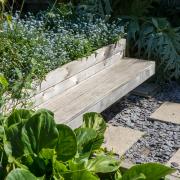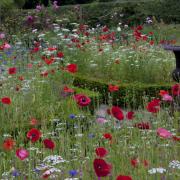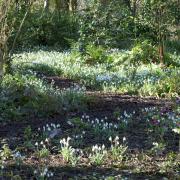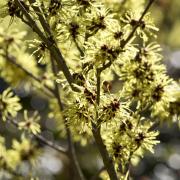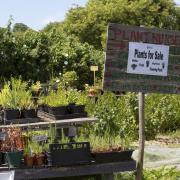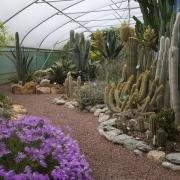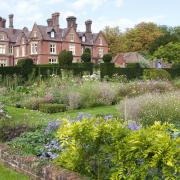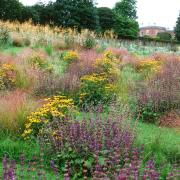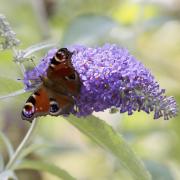We are all aware of buying locally or using seasonal home-grown food, but what about cut flowers?
In these challenging economic times it continues to be important to support our local businesses. We give a lot of thought to buying locally produced, seasonal food and now that is transferring to other products as well, such as cut flowers.
Many people in Kent are involved in growing cut flowers, from small-scale hobbyists to more commercial enterprises. We may still import 90 per cent of the flowers we buy in the UK, but that trend is changing.
Nothing beats the spontaneous, surprise gift of a billowing bunch of flowers. Flowers say I love you, I'm thinking of you, I'm sorry, thank you or congratulations, and buying cut flowers as gifts or to decorate our homes is as popular as ever.
As with food, buying locally and seasonally or growing our own flowers means they will be fresher and last longer. They are a sustainable antidote to mass-produced imported blooms. Flowers also require energy to grow and add to their carbon footprints as they travel from where they are produced.
Most of the flowers we buy come from Holland, Kenya, Columbia and Israel. Although we must consider the income generated for the millions involved, where possible buy locally produced cut flowers or, if you have space, grow some yourself.
Our climate is ideal for growing an array of beautiful seasonal flowers. The retail value of the cut flower industry is worth more than �2 billion, the same as our music industry. However, British growers have dwindled over the past 20 years, squeezed out of the market by larger mono-cultural growing units in Holland and other countries.
The trend may be reversing as a national campaign among retailers and growers aims to create awareness.
Start with your local florist
Alex White, a florist in Wingham, likes to support local growers and has a great selection through the year.
She says: "Wholesale grower Michael Minter supplies us year round with a wide range, including tulips, stocks, sweet William, arum, irises and dahlias, and Essentially Hops adds to the supply through the summer with evocative field-grown flowers. Lots of people appreciate locally grown as they are fresher, last longer and are cheaper."
The Little Stour Farm ShopThe Old StationCanterbury RoadWingham CT3 1NHTel: 01227 721199
Rebecca Frere works as a florist from her home studio near Aldington for a range of clients and events. She has also seen an increase in clients, especially brides, asking about the provenance of the flowers to be used.
"Flowers are my passion and each arrangement, whether big or small, traditional or contemporary, is important to someone and therefore important to me," she says.
"Where possible, I try to use seasonal flowers, many of which I grow myself. Otherwise I try to buy fair trade flowers, or flowers which have not been imported from too far afield. I think they should be as 'green' as possible," adds Rebecca.
Her cutting garden has flowers and foliage in an English country-style mix. "It helps to grow combinations of colour and textures to give me ideas. I love the scents of freshly grown flowers, rather than the overpackaged, very sprayed scentless blooms from overseas," she says.
"This year, I have made my cutting garden bigger and am growing lots of new things, in particular some gorgeous scented peonies in candy pinks and creams, zingy green echinacea, eye-popping zinnias, divine delphiniums, masses of alstroemerias and lots of wonderful sweet peas.
"I'm also going to dry flower petals to make lovely natural, biodegradable confetti for weddings."
Rebecca Frere FloristryTel: 07828 663494Email: rebeccafrere@googlemail.com
Meet some growers
Essentially Hops is one of many commercial wholesale growers across Kent, who range from backyard hobbyists, through flowerbeds on open fields to production glasshouses.
It's a family business, growing mainly hops for garlands, but also flowers and grasses, some for drying and increasingly as fresh, cut flowers.
There are spectacular massed blocks of colour in the fields, from blooms such as larkspurs, lavender, poppies and sunflowers, throughout the summer.
Amanda and Michael Barker met at Wye Agricultural College, married and set up business on Amanda's family hop and mixed farm. Following the decline of hop production, in 1989 Amanda's father stopped growing hops.
"But my mother had always had them in the house and believed in the old saying that if you have hops in the house you will never want for anything, and so my father kept one acre going for my mother's sake."
After success selling the harvested bines, or garlands, at the farm gate, Amanda and Michael experimented selling dried hops in floral displays, bags of hop flowers for pillows, plus a variety of kiln-dried flowers, by mail order and direct sales.
They have now diversified into selling cut flowers at the farm shop, to local retailers and wholesalers, and employ three florists for weddings.
"As British growers, we need to compete in the market, it's price led and we have found a niche market with organic flowers of high quality. Even with the credit crunch, it is economical to transform a room with flowers, fresh or dried, rather than decorate with sofas and curtains," says Amanda.
Essentially HopsChalkpit FarmAdisham Road, BekesbourneCanterbury CT4 5EU Tel: 01227 830666Tregothnan Estate is renowned for growing flowers in Cornwall for many years, but did you know that there is also Tregothnan Kent, near Mereworth, with the largest peony cutting garden in the UK?
More than 100,000 stems of five varieties are grown outdoors, harvested when the buds are still tight and sold through florists all over the UK, including many local outlets.
The estate describes peonies as "a quintessentially English part of our range of flowers and foliage."
Brian Spicer oversees the operation and is passionate about the peonies grown on Lord Falmouth's Kent estate by Tregothnan.
They plant the new root balls on ridges to aid drainage in the field, as peonies thrive in well-drained soil in a sunny position. Plenty of organic matter is integrated into the planting position and it is important not to plant peonies too deeply.
Tregothnan Estate OfficeTruroCornwallTR2 4ANTel: 01872 520000Email: info@tregothnan.com If you have been to the markets at Rolvenden or Cranbrook, or visited Taywell Farm Shop at Goudhurst in summer, you've probably seen the wonderful mixed bunches of colourful flowers grown by Julian Gurr.
On a small holding near Cranbrook, Julian and wife Nicci, a chef trained by the Roux brothers in London, have built up a food and growing business, aptly called Home GURRown. Their motto of 'He grows it, she cooks it', refers to Nicci's home-made ready meals also sold locally and the vegetables and fruit Jules produces for them.
In addition, some of the land has been given over to growing flowers, which runs in the family as Jules' dad John also grows chrysanthemums and sweet peas.
With a degree in environmental studies, Jules has been working their land for the past nine years and is committed to chemical-free produce. He showed me around, accompanied by daughter Daisy, pictured right, who helped pick some blooms as she toddled in and out the rows.
Cheerful cerise cosmos waved in the breeze, along with helichrysum, marigolds and gladioli, while later in the season there are also sunflowers, dahlias and asters. "I grow what works, are easy, grow well and are popular. Cut-and-come-again varieties are best," explains Jules.Some top tips from Jules include: buy seeds from a reputable catalogue, store correctly until sowing, use a sheltered, sunny spot, don't sow annuals too early, starting in containers in a greenhouse helps establish plants, deadhead and cut flowers regularly and do keep up the watering.
Home GURRownStarling CottageGolford Road, CranbrookTN17 3NTTel: 07747 816541Roadside kiosk from June
Meadow Grange Nursery augments its general plant and bedding production with cut-flower chrysanthemums, available only on site in November and December. A 10,000 sq ft glasshouse is planted up in the first week of July each year to ensure a supply for the Christmas period of spray and bloom chrysanthemums in a wide range of colours. "Packaging up is too expensive so we sell them from the nursery," explains owner, Paul Kennett.
Meadow Grange NurseryHoney HillWhitstableCT5 3BPTel: 01227 471205Open: Mon to Sat (8.30am to 6pm)December open seven daysFir Tree House Tea Room in Penshurst not only serves delicious teas, but also gives visitors the opportunity to admire the flowers decorating the atmospheric room.
In spring, you'll find bunches of stripy tulips and in summer, vibrant gladioli fill the eclectic mix of glazed vases.
Although you can also take tea in the pretty, cottage-style garden, these flowers weren't in evidence. On asking owners, Carolyn and Charles Fuller-Rowell, I discovered that they grow them on fields opposite, as a sideline to their renowned refreshments.
"We sell around 5,000 tulips each spring and gladioli in summer, at the tea room and also at the Shipbourne and Hildenborough Farmers' Markets.
"This year I am also experimenting with cosmos and larkspur. You need about 40 or 50 bunches to sell at market," explains Carolyn.
What started as a hobby and need in Charles to grow something has led to an interest they enjoy doing together. "Farming the land is in my blood, I felt I should be doing some manual work in a field," says Charles.
"My sister actually suggested that we grow tulips, as they are expensive and not always very nice, so we decided to grow stripy, sturdy varieties. Gladioli were a good choice for summer as they grow easily outside and last well in a vase."
Fir Tree House Tea RoomPenshurstTN11 8DB Tel: 01892 870382Open: Wed-Sun (2.30pm to 6pm) and Bank Holidays, 1 April to end October
At home
If you have the space, try growing cut flowers at home, either mixed throughout or in a dedicated cutting garden if you can't bring yourself to cut from the main display. Arranging lavish flowers you have grown yourself or giving bunches to friends is a real pleasure.
You can have a year-round supply with spring, summer, autumn and winter choices. Use some old-fashioned varieties for blowsy, scented arrangements that will fill your senses. Don't forget the value and beauty of foliage as well.
Godinton House has a dedicated cutting garden, growing a vast range for floral arrangements in the house. "The joy of a cutting garden is being able to pick armfuls of flowers as I never feel comfortable picking in the main garden," says head gardener, Vivien Hunt.
Apart from the famous collection of delphiniums, there are beds billowing with cut-and-come-again flowers throughout summer. By growing annuals and perennials along with foliage choices, there is a long season of material to use. Some of Viv's favourites include cosmos, rudbeckias, dahlias, alchemilla mollis and sweet peas.
Viv offers some good advice for the home gardener. "Dig in organic matter to keep fertility higher, mulch perennials in autumn or spring and cut them down in autumn.
"Collect seeds rather than let plants self seed. We cut our flowers in the evening and put them inside in buckets of water to condition before arranging the following morning."
Godinton House and GardensGodinton LaneAshford, TN23 3BPTel: 01233 620773Email: info@godinton-house-gardens.co.uk Open: Thur to Mon (2pm to 5.30pm) until 27 OctoberSue and David Heaton's village garden in Hunton gave me the chance to see a cutting garden on a more domestic scale. This lovely private garden opens every couple of years through the National Gardens Scheme and has a dedicated area designed for cutting flowers and foliage for the house.
They have converted a small parterre, originally filled with vegetables, into a framework for cut blooms. "I like the sense of formality of the box hedges offsetting the bright colours of the flowers," explains Sue.
A succession of blooms, including tulips, anemones, irises, cornflowers, alliums, nigella, nicotiana, salvia, sweet William, zinnias, dahlias and chrysanthemums, allow delightful choices through the year.
Colours are selected to work harmoniously together in arrangements, with brighter colours in spring and autumn and softer blues and burgundies in summer. "There is nothing too pastel, as the garden faces south, with sun most of the day, so you need strong colours," explains Sue.
3 New CottagesHuntonOpen June 2010 with the NGS
Top tips for a cut flower garden
• Select a sunny spot with well-drained fertile soil and sheltered from strong winds
• Grow a mix of annuals and biennials with perennials as the backbone to your supply
• Plant spring, summer and autumn blooms along with interesting foliage in successional planting
• Use self-replenishing plants that will produce more flowers after cutting
• Cutting encourages more flowers to grow
• Sow seeds or plant seedlings
• Ensure you can reach the flowers easily with wide paths
• Combine plants of similar heights and flowering times
• Stake plants if needed
• If using existing borders, plant large groups so cutting some of the blooms won't spoil the garden
• Use a cutting garden to experiment with new plants and colours
• As it is primarily a production garden, you don't need to worry about design and colour combinations
• Some people choose to grow in rows like traditional vegetable plots for ease of maintenance
• Plant suggestions: achillea, allium, alstroemeria, ammi majus, bells of Ireland, calendula, campanula, cleome, cosmos, coreopsis, dahlia, delphinium, echinacea, gladioli, gypsophila, helichrysum, phlox, poppy, rudbeckia, salvia, scabiosa, snapdragon, sunflower, sweet pea, zinnia
Tips to make your cut flowers last
• Cut early morning before morning dew has dried, when their stems are filled with stored food. Flowers gradually dehydrate as the day warms up
• Cut on a slant of about 45
• Remove leaves that will be under water
• Plunge immediately into lukewarm water
• Change the vase water every two days
• Keep out of direct sunlight
• Different types of flowers are harvested at appropriate stages in their development. Flowers with multiple buds on each stem should have at least one bud showing colour and one bud starting to open before being cut. Flowers that grow on individual stems should be cut when open
• Use clean, sharp knife or shears
• Cut long stems, about one inch from the bottom of the main stem
• Keep away from fruit, which releases ethylene, a gas that causes flowers to age faster
• Home-made flower preservative can be added to the water - one teaspoon sugar, one teaspoon bleach, two teaspoons lemon juice to approx. one litre of water





